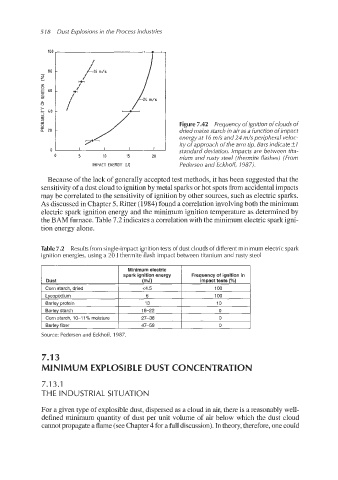Page 551 - Dust Explosions in the Process Industries
P. 551
5 18 Dust Explosions in the Process Industries
IO(
- 80
2
z
0
E 60
z
!2
LL
0
& 40
i
m
a
m Figure 7.42 Frequency of ignition of clouds of
0
E 20 dried maize starch in air as a function of impact
energy at 16 m/s and 24 m/s peripheral veloc-
ity of approach of the arm tip. Bars indicate +I
0 standard deviation. Impacts are between tita-
0 5 10 15 20 nium and rusty steel (thermite flashes) (From
IMPACT ENERGY lJ1 Pedersen and Eckhoff, 1987).
Because of the lack of generally accepted test methods, it has been suggested that the
sensitivityof a dust cloud to ignition by metal sparks or hot spots from accidentalimpacts
may be correlated to the sensitivity of ignition by other sources, such as electric sparks.
As discussed in Chapter 5, Ritter (1984) found a correlationinvolving both the minimum
electric spark ignition energy and the minimum ignition temperature as determined by
the BAM furnace. Table 7.2 indicates a correlation with the minimum electric spark igni-
tion energy alone.
Table 7.2 Results from single-impact ignition tests of dust clouds of different minimum electric spark
ignition energies, using a 20 J thermite flash impact between titanium and rusty steel
Minimum electric
spark ignition energy Frequency of ignition in
Dust (mJ) impact tests (%)
Corn starch, dried 4.5 100
Lycopodium 6 100
Barley protein 13 10
Barley starch 18-22 0
Corn starch, 10-1 1% moisture 27-36 0
Barley fiber 47-59 0
7.13
MINIMUM EXPLOSIBLE DUST CONCENTRATION
7.1 3.1
THE INDUSTRIAL SITUATION
For a given type of explosible dust, dispersed as a cloud in air,there is a reasonably well-
defined minimum quantity of dust per unit volume of air below which the dust cloud
cannot propagatea flame (see Chapter4 for a full discussion).In theory,therefore,one could

